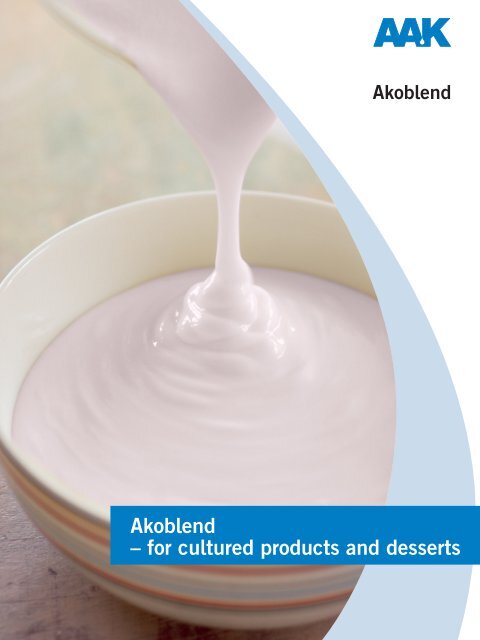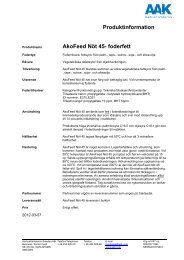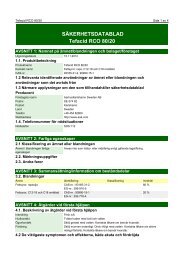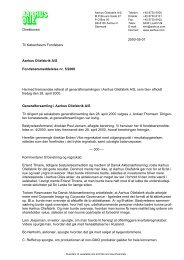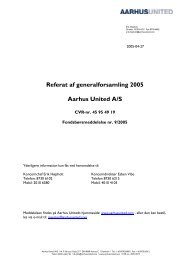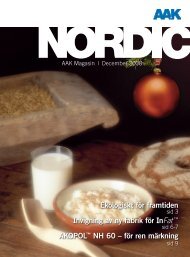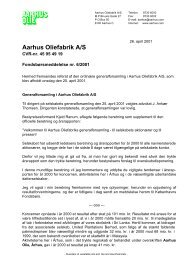Akoblend – for cultured products and desserts - AAK
Akoblend – for cultured products and desserts - AAK
Akoblend – for cultured products and desserts - AAK
Create successful ePaper yourself
Turn your PDF publications into a flip-book with our unique Google optimized e-Paper software.
<strong>Akoblend</strong><br />
<strong>Akoblend</strong><br />
<strong>–</strong> <strong>for</strong> <strong>cultured</strong> <strong>products</strong> <strong>and</strong> <strong>desserts</strong>
Cultured <strong>products</strong> <strong>and</strong> <strong>desserts</strong><br />
The main reason <strong>for</strong> using vegetable<br />
fat in <strong>cultured</strong> <strong>products</strong> beside price<br />
is the nutritional value. Vegetable fats<br />
are used to incorporate high amounts<br />
of mono- <strong>and</strong> polyunsaturated fatty<br />
acids <strong>and</strong> to decrease the amount of<br />
saturated fat; they are also high in<br />
omega 3 content.<br />
Taste <strong>and</strong> taste stability<br />
Due to its composition, milk fat has a<br />
characteristic creamy/buttery flavour<br />
that vegetable fat lacks. To replace<br />
milk fat <strong>and</strong> still maintain the quality<br />
of the finished product, the vegetable<br />
fat must have a bl<strong>and</strong> taste without<br />
any off flavour also during storage. The<br />
bl<strong>and</strong> flavour <strong>and</strong> high flavour stability<br />
is obtained through a careful selection<br />
of oil raw materials <strong>and</strong> appropriate,<br />
optimised refining of the oils.<br />
Cultured creams<br />
Various kinds of <strong>cultured</strong> creams such<br />
as soured cream, crème fraîche <strong>and</strong><br />
smetana are produced from vegetable<br />
fat blends. Except <strong>for</strong> differences in fat<br />
content, these <strong>products</strong> vary in taste,<br />
sourness <strong>and</strong> consistency. It is important<br />
to retain these properties when<br />
replacing milk fat with vegetable fat<br />
totally or partially. It is also vital to obtain<br />
a stable cream that does not separate<br />
the water phase. These proper ties<br />
are obtained by using <strong>Akoblend</strong> in<br />
combination with correct processing,<br />
<strong>and</strong> possibly an additional stabiliser.<br />
If combined <strong>products</strong> of milk <strong>and</strong><br />
vegetable fat are produced, then<br />
ordinary cream <strong>and</strong> cream base on<br />
vegetable fats are blended to the<br />
desired proportions. This mixed cream<br />
is then homogenised, heat treated <strong>and</strong><br />
fermented in the usual way.<br />
Yoghurts<br />
Yoghurt is one example of <strong>products</strong><br />
that can be made by recombination<br />
using a suitable vegetable fat together<br />
with skimmed milk, or dry ingredients<br />
<strong>and</strong> water. This is especially useful<br />
<strong>for</strong> high fat creamy dessert yoghurts.<br />
<strong>Akoblend</strong> or other special nutritional<br />
blends are used <strong>for</strong> this application.<br />
Yoghurts with specific health claims,<br />
functional food, may be <strong>for</strong>mulated by<br />
<strong>Akoblend</strong><br />
combining fats like <strong>Akoblend</strong> together<br />
with other specific <strong>for</strong>mulated <strong>products</strong><br />
from <strong>AAK</strong>.<br />
Desserts<br />
Milk <strong>and</strong> cream based <strong>desserts</strong>, like<br />
mousse <strong>and</strong> puddings, can be made<br />
from a vegetable fat based milk emulsion.<br />
The fat influences the rheological<br />
properties, like viscosity of the dessert<br />
as well as contributing to the sensory<br />
profile.<br />
<strong>AAK</strong> st<strong>and</strong>ard product <strong>for</strong> all these<br />
applications is <strong>Akoblend</strong>, that is non<br />
trans, non hydro <strong>and</strong> low in saturated<br />
fatty acids.<br />
Stale<br />
The sensory The analyse sensory shows analyse an shows oil blend an<br />
with bl<strong>and</strong> taste without off-flavours<br />
Oxidised<br />
Bitter<br />
Nutty<br />
Old nut<br />
Linseed oil<br />
Seed<br />
Fishy<br />
Neutral<br />
www.aak.com<br />
October 2011


